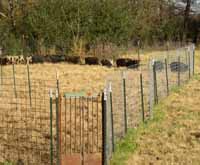 |
Front Page
A better feral hog trap: When trapping large groups, bigger is better
By Blair Fannin, Texas A&M
Jan 2, 2006
COLLEGE STATION – Bigger is better when it comes to trapping feral hogs. 
As Texas' feral hog population continues to destroy crops and rangeland across the state, small traps are a popular control method among landowners with only a few hogs on the premises. But when feral hogs invade in double digits, constructing a trap as big as your living room is not out of the question.
"If you're trying to trap a big group, small traps are not the way to go," said Dr. Billy Higginbotham, Texas Cooperative Extension wildlife specialist at Overton.
As an alternative, Higginbotham recommends constructing a teardrop-shaped trap using sheep or goat panels 30- feet wide by 50-foot long. The panels can be secured by using T-posts. The gate to the trap is placed at the neck of the teardrop.
"You need to use a gate that's hinged or a saloon door that's spring-driven," he said.

A spring-driven saloon door allows feral hogs to enter the trap but not escape. (Texas Cooperative Extension photo)
A welder can construct the saloon gate using two small sheets of flat iron welded to rebar at the bottom of the gate. This will prevent escape attempts at the bottom of the gate.
Next, Higginbotham recommends digging a small pit near the back of the pen, which will hold shelled corn, soured mash or other bait to attract the hogs. The bait pit will also include the trip wire used to close the front gate when triggered.
Higginbotham advises applying bait both outside and inside the trap, leaving the gate open for several days. The hogs will become acclimated and attract large numbers inside the trap once the trip door is set.
"This technique will allow a whole pack to be caught at one time, as many as 20 to 25 hogs," Higginbotham said.
Once the hogs are trapped, Higginbotham said the expense of buying panels and shelled corn can be recovered.
"There are some meat processing companies that are paying 60 cents a pound for hogs weighing more than 250 pounds. They are also paying a bonus of $10-$20 a head," he said.
Those with access to a trailer can place a railroad tie underneath the rear of the trailer and open the gate. By walking to the back of the pen, the feral hogs will move forward and load into the trailer.
Feral hog control is a continuous process and is even more effective when neighbors are working together, Higginbotham said.
"When we look at management of feral hogs, think of them as four-legged fire ants," he said. "We can control the numbers, but as far as eradicating them off the earth, that's probably not going to happen."
Higginbotham said the problem is landowners aren't using efficient means to control them.
"People are trying to shoot and trap them, but they're using these small traps (for large groups)," he said. "We can become even more effective if we trap and do it with our neighbors. I think eradication is fleeting and temporary. I can keep fire ants out of my yard and my neighbors can apply control methods, but if we don't keep up the effort, they're going to be back."
For more information on feral hogs, go to the Web at http://feralhog.tamu.edu/ .